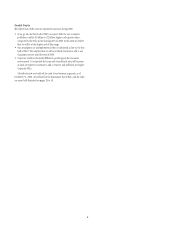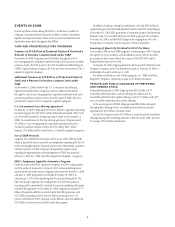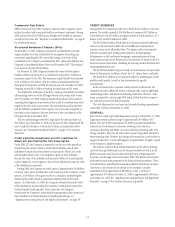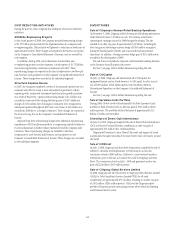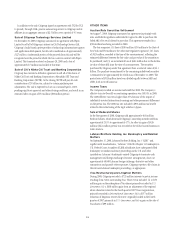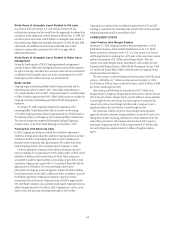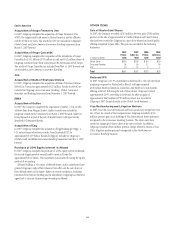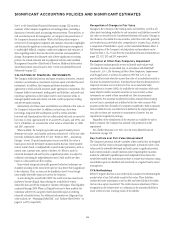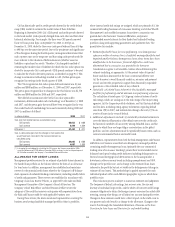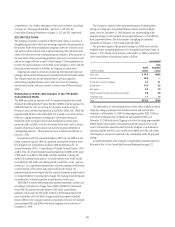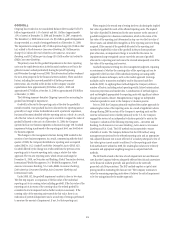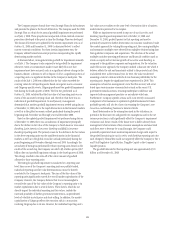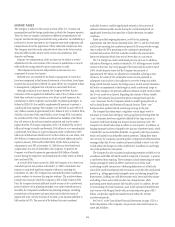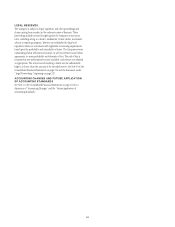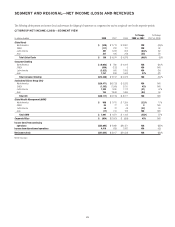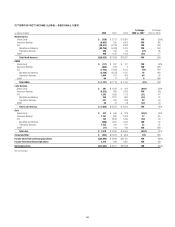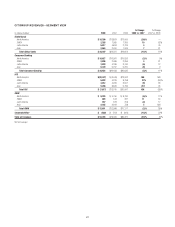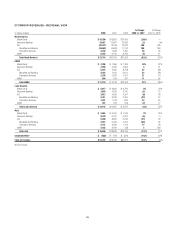Citibank 2008 Annual Report Download - page 24
Download and view the complete annual report
Please find page 24 of the 2008 Citibank annual report below. You can navigate through the pages in the report by either clicking on the pages listed below, or by using the keyword search tool below to find specific information within the annual report.SIGNIFICANT ACCOUNTING POLICIES AND SIGNIFICANT ESTIMATES
Note 1 to the Consolidated Financial Statements on page 122 contains a
summary of the Company’s significant accounting policies, including a
discussion of recently issued accounting pronouncements. These policies, as
well as estimates made by management, are integral to the presentation of
the Company’s financial condition. While all of these policies require a
certain level of management judgment and estimates, this section highlights
and discusses the significant accounting policies that require management
to make highly difficult, complex or subjective judgments and estimates, at
times regarding matters that are inherently uncertain and susceptible to
change. Management has discussed each of these significant accounting
policies, the related estimates and its judgments with the Audit and Risk
Management Committee of the Board of Directors. Additional information
about these policies can be found in Note 1 to the Consolidated Financial
Statements on page 122.
VALUATIONS OF FINANCIAL INSTRUMENTS
The Company holds fixed income and equity securities, derivatives, retained
interests in securitizations, investments in private equity and other financial
instruments. In addition, the Company purchases securities under
agreements to resell and sells securities under agreements to repurchase. The
Company holds its investments, trading assets and liabilities, and resale and
repurchase agreements on the balance sheet to meet customer needs, to
manage liquidity needs and interest rate risks, and for proprietary trading
and private equity investing.
Substantially all of these assets and liabilities are reflected at fair value on
the Company’s balance sheet. In addition, certain loans, short-term
borrowings, long-term debt and deposits as well as certain securities
borrowed and loaned positions that are collateralized with cash are carried at
fair value. In total, approximately 33.2% and 38.9% of assets, and 19.9% and
23.1% of liabilities, are accounted for at fair value as of December 31, 2008
and 2007, respectively.
When available, the Company generally uses quoted market prices to
determine fair value, and classifies such items within Level 1 of the fair value
hierarchy established under SFAS 157 (see “Events in 2007—Accounting
Changes” above). If quoted market prices are not available, fair value is
based upon internally developed valuation models that use, where possible,
current market-based or independently sourced market parameters, such as
interest rates, currency rates, option volatilities, etc. Where a model is
internally developed and used to price a significant product, it is subject to
validation and testing by independent personnel. Such models are often
based on a discounted cash flow analysis.
Items valued using such internally generated valuation techniques are
classified according to the lowest level input or value driver that is significant
to the valuation. Thus, an item may be classified in Level 3 even though
some readily observable inputs are used in the valuation.
As seen during the second half of 2007, the credit crisis has caused some
markets to become illiquid, thus reducing the availability of certain
observable data used by the Company’s valuation techniques. This illiquidity
continued through 2008. When or if liquidity returns to these markets, the
valuations will revert to using the related observable inputs in verifying
internally calculated values. For additional information on Citigroup’s fair
value analysis, see “Managing Global Risk” and “Balance Sheet Review” on
pages 51 and 78, respectively.
Recognition of Changes in Fair Value
Changes in the valuation of the trading assets and liabilities, as well as all
other assets (excluding available-for-sale securities) and liabilities carried at
fair value are recorded in the Consolidated Statement of Income. Changes in
the valuation of available-for-sale securities, other than write-offs, generally
are recorded in Accumulated other comprehensive income (loss), which is
a component of Stockholders’ equity on the Consolidated Balance Sheet. A
full description of the Company’s related policies and procedures can be
found in Notes 1, 26, 27 and 28 to the Consolidated Financial Statements on
pages 122, 192, 202 and 205, respectively.
Evaluation of Other-than-Temporary Impairment
The Company conducts periodic reviews to identify and evaluate each
investment that has an unrealized loss, in accordance with FASB Staff
Position No. 115-1, The Meaning of Other-Than Temporary Impairment
and Its Application to Certain Investments (FSP FAS 115-1).An
unrealized loss exists when the current fair value of an individual security is
less than its amortized cost basis. Unrealized losses that are determined to be
temporary in nature are recorded, net of tax, in Accumulated other
comprehensive income (AOCI) for available-for-sale securities, while such
losses related to held-to-maturity securities are not recorded, as these
investments are carried at their amortized cost (less any permanent
impairment). For securities transferred to held-to-maturity from Trading
account assets, amortized cost is defined as the fair-value amount of the
securities at the date of transfer. For securities transferred to held-to-maturity
from available-for-sale, amortized cost is defined as the original purchase
cost, plus or minus any accretion or amortization of interest, less any
impairment recognized in earnings.
Regardless of the classification of the securities as available-for-sale or
held-to-maturity, the Company has assessed each position for credit
impairment.
For a further discussion, see Note 16 to the Consolidated Financial
Statements on page 158.
Key Controls over Fair-Value Measurement
The Company’s processes include a number of key controls that are designed
to ensure that fair value is measured appropriately, particularly where a fair-
value model is internally developed and used to price a significant product.
Such controls include a model validation policy requiring that valuation
models be validated by qualified personnel independent from those who
created the models and escalation procedures to ensure that valuations using
unverifiable inputs are identified and monitored on a regular basis by senior
management.
CVA Methodology
SFAS 157 requires that Citi’s own credit risk be considered in determining the
market value of any Citi liability carried at fair value. These liabilities
include derivative instruments as well as debt and other liabilities for which
the fair-value option was elected. The credit valuation adjustment (CVA) is
recognized on the balance sheet as a reduction in the associated liability to
arrive at the fair value (carrying value) of the liability.
18


